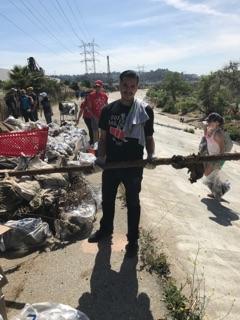Good afternoon my fellow friends! My name is Richard Chavez and I am currently enrolled in English 2030 with professor Ximena Hernandez. On Saturday April 22, 2017 I had the great privilege in taking part of cleaning up the Los Angeles river. I had heard several stories about the river's condition, but I was excited to see it firsthand myself. As soon as I entered the parking lot I was amazed to see how many volunteers there were. I was warmly welcomed and given a bag as well some gloves. With my tools at hand I made my way down to the river’s entrance. At first glance I was amazed at how far the river extended and optimistic from seeing the flowing water in the river, but that all changed once I took a closer look at things. The beautiful scenery from far was overshadowed by the varying size pieces of trash that were scattered all across the river and its shoreline. As I began my journey on the shoreline I was coming across a lot of different sized plastics and other trash. You could find bits of trash in almost every nook and cranny within the river.
Picture 1: The trash can be literally found everywhere. This tree is being affected by the actions of humans.
I was confused at how some of these items even arrived to this location. Everyday items from shampoo bottles to can openers were spread across the shoreline. Finding these items left a lot of volunteers including myself in shock. Though these items were a bit strange I couldn’t help, but notice that my trash bag was rapidly filled up by large quantities of metal. I thought plastics were the main issue affecting the Los Angeles River. Little did I know that metals also had a huge impact on the environment. These metals were laid on top of trees and other plants which prevented them from growing. I noticed that a lot of volunteers would walk past the metals mainly because they were heavy. I thought to myself and said, “Isn’t the objective to pick up all the trash near and in the river?.” With this in mind I made it my mission to haul every piece of metal that I came across and bring it up to the trash container. While on my journey I came across several large pieces of metal including: a couple of shopping carts, metal wheels, parts from a washing machine, and industrial pipes. Hauling all this metal was a challenge, but it had to be done in order to protect the river.
Picture 2: Several pieces of metal that I came across while on my adventure.
Humans need to wake up and realize the importance of taking care of their environment. In particular, we should focus on protecting our rivers because they are necessary for the survival of our ecosystems. The plants and animals around a river would not thrive and or even exist if the rivers that they depended on were polluted. Humans throw away their trash which contain different metals and plastics and that trash eventually enters through a storm drain which leads up to local rivers and lastly our oceans. These pieces of trash add deadly toxins into the environment and they eventually end up in the systems of humans through consumption. The Los Angeles River is currently facing this issue, but in a smaller scale compared to that of the Great Pacific Garbage Patch. The director, Angela Sun, created the film, “Plastic Paradise: The Great Pacific Garbage Patch”, which discussed the growing issue of a floating island of trash affecting ecosystems such as coral reefs in the Pacific Ocean. This island of trash is roughly the size of Texas and it was a result of careless actions caused by humans. Angela Sun stated, “All of this trash and plastic is what we throw away on an everyday basis” (Film). Human’s carelessly throw away their trash without realizing the unintended consequences. Many times animals confuse these plastics for food and that eventually kills them. To add on, plastics break down into smaller components and they release toxic chemicals into the water which are then consumed by different types of marine life. These animals are then consumed by humans and so we are ingesting the toxins that we initially released. This issue is a serious problem because our trash is destroying key ecosystems that ensure our survival. Humans depend on local ecosystems for food as well as livelihood and so without them our species could go extinct. In terms of the Los Angeles River we need to make sure that it is safe and pollutant free because the trash that arrives in that river eventually ends up in our oceans. By stopping this issue at its source we are ensuring the survival of our ecosystems and our species for generations to come.
All together this event was eye opening while at the same time disheartening. It was disheartening in the sense that humans are the ones responsible for destroying this once-beautiful environment. The irresponsible act of humans throwing away trash in the river has polluted it and nearly wiped it out. Luckily, good Samaritans have stepped forward in an effort to save the river, but a long battle still awaits. This experience was eye opening because it showed me that small individual efforts such as picking up trash from the river can go a long way in changing the future. Overall, it was a successful earth day!
Picture 3: The finished product from my wonderful day.
Picture 4: Call me the metal collector! This was the largest piece of metal that I retrieved from the river.





No comments:
Post a Comment